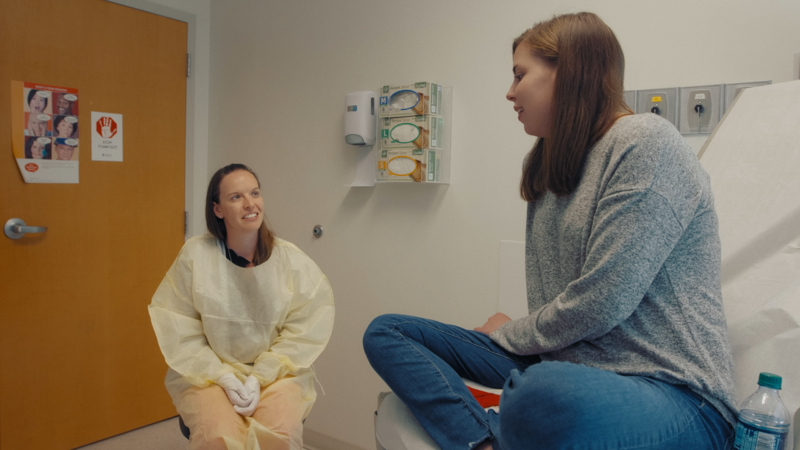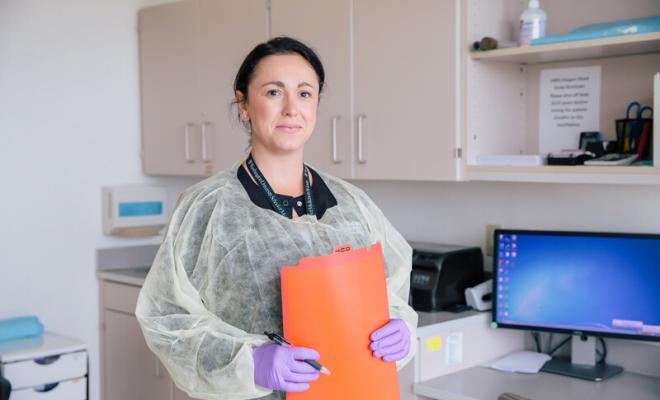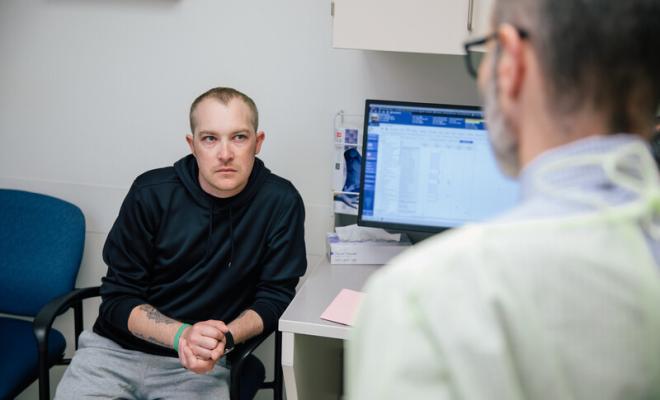A referral allows you to meet with the transplant team. They will assess your medical status and provide their expert opinion on your need for a lung transplant. Then they may recommend completing part or all of the transplant evaluation to help assess your candidacy for a transplant.
A referral is not the same as an evaluation, and an evaluation does not necessarily lead to immediate listing for transplant. The goal is to assess your need for transplant while also identifying any potential barriers so they can be addressed before being listed for a transplant.
Declining lung function plays an important part in determining when you should be referred to a transplant program by your cystic fibrosis care team. But there are also other factors that your care team will consider before they recommend that you meet with a transplant team and possibly be evaluated for a lung transplant.
Lung Function
Although it's not the only factor, declining lung function is a key indicator for transplant referral. Cystic Fibrosis Foundation lung transplant referral guidelines recommend that your care team talks to you about lung transplant as a possibility when your forced expiratory volume in one second (FEV1) drops below 50 percent predicted.
Many people will not need to receive a transplant at this stage, but it is important to start the conversation early.
Talking about transplant early and being referred early will give you more time to work with your CF care team and the transplant team to learn as much about the transplant process as possible. This includes learning about the benefits and risks and identifying any factors that may prevent you from being listed.
Overcoming barriers to being listed could take time, so the sooner they are identified, the more time you, your family, and your CF care team can have to work on them. Also, talking about transplant before you need an urgent evaluation or listing gives you the opportunity to make a fully informed decision without the added pressure of being severely ill.
Markers of Increased Disease Severity
Although declining lung function is an important measure, other factors have been identified that may signal the need for referral — even if your lung function is not low enough to qualify for immediate transplant. Care teams may consider these factors in addition to lung function, or independent of lung function, when deciding when to recommend transplant referral. These factors are referred to as “markers of increased disease severity,” and include:
- Inability to walk 400 meters (about 440 yards) in six minutes (called a six-minute walk test)
- Low levels of oxygen in your blood (hypoxemia)
- High levels of carbon dioxide in your blood (hypercapnia)
- High blood pressure in the arteries to the lungs (pulmonary hypertension)
- Body mass index (BMI) less than 18.
- More frequent pulmonary exacerbations — more than two pulmonary exacerbations per year that need to be treated with intravenous (IV) antibiotics or one exacerbation that requires positive pressure ventilation using bilevel noninvasive ventilation or mechanical ventilation via tracheostomy or endotracheal tube
- Coughing up a large amount of blood (massive hemoptysis)
Because these markers may indicate shortened survival, the guidelines recommend that people with reduced lung function (FEV1 less than 40 percent predicted) be assessed by their care team for markers of shortened survival. If you are found to have one or more of these markers, you should be referred for a transplant evaluation.
| When | Your care team may |
| 1. Your FEV1 is less than 50 percent predicted | Talk to you about transplant as a possible future option |
| 2. Your FEV1 decreases to less than 40 percent predicted without exacerbation |
|
| 3. Your FEV1 decreases to less than 30 percent predicted without exacerbation | Refer you for transplant evaluation |
Other Circumstances
In addition to lung function and markers of increased disease severity, your care team may also recommend a lung transplant referral if:
- You are a woman between the ages of 18 to 25 years and have CF-related diabetes, rapidly declining FEV1, or rapidly declining BMI.
- You are less than 5 feet 3 inches and your FEV1 is less than 40 percent predicted.
- Your BMI is less than 18 and your FEV1 is less than 40 percent predicted while you are trying to gain weight.
- Your FEV1 is less than 40 predicted predicted and you have more than two pulmonary exacerbations per year that require IV antibiotics.
- You have one pulmonary exacerbation that requires positive pressure ventilation (such as CPAP, BiPap, or ventilator support), in which case your care team may recommend a transplant referral despite a higher FEV1.
- Your FEV1 is less than 40 percent predicted and you have massive hemoptysis that requires admission to the intensive care unit (ICU) or bronchial artery embolization to stop the bleeding.
- Your FEV1 is less than 40 percent predicted and you have had a pneumothorax.
What Does It Take to Be a Candidate for Transplant?
As part of the evaluation, the transplant team may identify specific barriers to transplant. There are some barriers that you may be able to overcome and some that may be harder to change.
Learning about these barriers as part of the early referral process for transplant can give you more time to work with your CF and transplant care teams to become a stronger candidate for lung transplant.
"As I prepared to leave the hospital, I asked for a list of all the reasons I wasn't able to be listed for a transplant. Then, my team, my family, and I made the list of 'impossible' goals. I placed the list on the front of my refrigerator, my [do not resuscitate] form on the side of the fridge. Every day for that next year, I dedicated myself to checking items off that list until I was done." — Caleigh Haber, an adult with CF and two-time lung transplant recipient, from the CF Community Blog
Barriers That Are Harder to Change
Some of the barriers to transplant that are harder to change include:
- Certain infections (Burkholderia cenocepacia, Burkholderia gladioli, Burkholderia dolosa, Mycobacterium abscessus, and Scedosporium prolificans)
- Poor kidney function (called renal insufficiency)
- Liver disease
- Critical or unstable clinical conditions, such as mechanical ventilation or extracorporeal membrane oxygenation (ECMO)
- Heart problems
- Past chest surgery, such as surgical treatment for a collapsed lung (pneumothorax)
- Past lung transplant
- Past cancer
Although you may not be able to change any of these factors, many transplant centers have different policies about what they consider barriers or contraindications to transplant.
Some transplant centers may not accept people with certain health conditions, while others may. For this reason, it helps to research multiple centers and understand the policies of each center.
The following organizations offer CF-specific information to help you learn more about lung transplant centers:
- The Scientific Registry of Transplant Recipients (SRTR) gathers a wide range of information on transplant waiting lists, donor-recipient matching, and transplant recipients in the United States.
- The International Society for Heart and Lung Transplantation (ISHLT) maintains an international transplant registry that contains statistics on outcomes, survival, and risk factors, which it updates yearly.
Barriers You May Be Able to Change
Barriers to transplant that you may have more control over include:
- Being underweight: If your body mass index (BMI) is less than 18, it may prevent you from being listed for a transplant at some transplant centers. However, your care team can help you gain the necessary weight with nutritional supplements or by placing a gastrostomy tube (G-tube).
- Substance misuse, including long-term use of opiates or narcotics, inhaled marijuana, alcohol, and inhaled tobacco products: Your care team can help you find treatment including behavioral treatment, medication, outpatient or inpatient treatment, and peer support.
- Cystic fibrosis-related diabetes (CFRD) that is not well controlled: People who have uncontrolled CFRD are more likely to experience pulmonary exacerbations and have weight problems. CFRD can be managed with insulin, blood sugar monitoring, a balanced diet as recommended by your CF and diabetes care team, and exercise.
Starting the conversation about lung transplant before you need to be listed gives you more time to work with your CF care team and the transplant team to address potential barriers. Working to correct the identified barriers to transplant will show the transplant team that you are engaged in your care and that you want to become a stronger candidate for transplant at their center.
"I also feel it is extremely important for the CF care center team to advocate for their patients. You will see in my video how lucky I have been to have such a wonderful CF care team that worked to find a transplant facility." — Mindy Ladd, adult with CF, from the CF Community Blog
Emotional Support
The process of waiting for, receiving, and then recovering from a lung transplant can be long and stressful — for you and for your loved ones. You and your family may want to talk to others who are going through or have gone through a lung transplant to understand what you're feeling — both before and after the transplant.
"It is equally important for family caregivers to have ideas for keeping their loved ones' mental health intact. For example, my mother purchased a small fan for my room because my hot flashes made me feel miserable. She also asked the doctors if I could suck on hard candy since I was unable to eat or drink for weeks." — Jenavese Armstrong, an adult with CF, from the CF Community Blog
There are aspects of the transplant process that people may not understand unless they have been through it themselves. CF Peer Connect is a one-to-one peer support program for people with CF and their family members ages 16 and older. Connecting with a peer mentor provides an opportunity to talk with and learn from someone who is also affected by CF and has gone through similar experiences, such as lung transplant.
Other forms of social support from the CF community can be found in virtual community conferences and small-group discussions called CF Circles. These programs provide the opportunity to connect, share, and learn from peers through open and honest conversation.
Institution-Provided Support
Your lung transplant center may offer you support throughout the transplant process, including psychological support, education, support groups, and Facebook groups. Some transplant centers have access to transplant psychiatrists, who are doctors trained in psychiatry with a special focus on people going through the transplant process. CF care center social workers and transplant center social workers can also help you throughout this process. Learn about transplant centers across the country, including the one you may be referred to by your CF care team.


